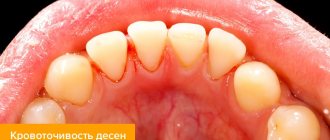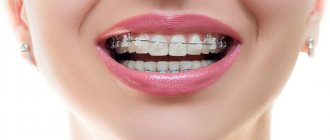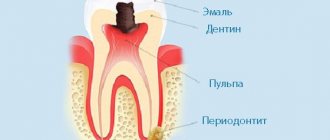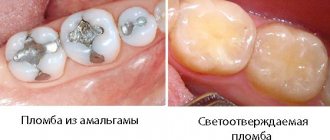Installing a crown on a tooth is one of the prosthetic options used when one or more dental units in a row are lost. Sometimes a dental crown is required even in the absence of a single edentia - for example, if it is necessary to restore the aesthetics of the dentition in the smile area. There are specific indications and contraindications for the procedure, and it is performed in several stages. We will discuss the specifics of the process of installing dental crowns in detail below.
After reading the material, you can find out how to install a crown on a tooth, what types of structures can be used in the procedure, and whether the process will be painful for the patient. We will also separately consider the specifics of removing a dental crown.
Calculate the cost of treatment by taking a short test in 20 seconds!
Do not delay your treatment, because in this matter time plays against us.
What is preparation or grinding of enamel: a complete list of indications for this procedure
Article navigation
- What is preparation
- What preparation is needed before turning?
- Types of turning
- Peculiarities of turning for different types of prostheses
- Types of ledges when fixing crowns
- Features of the procedure in children
- Will it hurt when turning?
- What to do if there is pain after turning
- Is preparation always necessary?
- How much will the turning cost?
Question to a specialist
To restore “problematic” or missing teeth, we go to an orthopedic dentist who offers various prosthetic options.
However, the installation of a veneer, crown, removable dentures or bridge is almost always preceded by dental grinding - and the very mention of it immediately frightens patients. What kind of procedure is this, in what situations is it used, will it hurt, what are the features of the preparation and how the process works in patients of different ages - all this is discussed in today’s material.
What is preparation
At its core, the preparation process involves removing part of the hard tissue. This layer, represented by enamel (the outer shell) and dentin (these are the internal tissues), must be equal to the thickness of the prosthesis. Armed with a bur, the doctor cuts off the excess and gives the crown the shape on which the prosthesis will easily and reliably fit. It is important to ensure maximum density and absolute accuracy of its fit. As a rule, the shape of a natural tooth is a cone or cylinder.
Relatively speaking, you will have to “cut off” the amount that is equal to the thickness of the prosthesis. For example, zirconium dioxide will require minimal grinding, but metal-ceramics (after all, there are both ceramics and metal) will require the removal of a thicker layer of living tissue.
Preparation is also carried out during filling, but in this case only inflamed tissues are removed, while healthy ones are preserved. If you need to install a prosthesis, even living tissue will have to be removed.
What preparation is needed before turning?
In order to secure the future prosthesis well, the prepared crown must be strong, free of plaque and stone, and free of carious lesions (if any, the doctor will, of course, remove them first). Also, before treating the enamel under any prosthesis, it is important to remove soft and hard plaque.
Only until 30.09 South Korean implant Osstem - 19,900 rubles.
Hurry up to sign up for a free consultation and lock in promotional prices.
Call now or request a call
Opening hours: 24 hours a day - seven days a week
Types of turning
The choice of technique depends mainly on the individual clinical picture, as well as on the volume of tissue that needs to be trimmed. There are types that are more extended in time, and there are very fast, safe and pass without the slightest pain. Let's look at all of them that currently exist. But keep in mind that the choice always remains with the attending physician, who will assess the situation and select the most optimal option.
Ultrasonic
This method involves the use of a special apparatus that produces high-frequency vibrations - ultrasonic. And the device itself is called a “scaler” or “scaler”. By the way, it is used to clean enamel from plaque. Also, instead of a scaler, a piezo device can be used - its action is again based on the use of ultrasonic waves, but they are more powerful, which allows it to be used on harder tissues.
During the procedure, the doctor does not touch the enamel with the instrument. Almost no heating occurs. So the risk of damage disappears. As for pain, it may well occur if there is increased sensitivity, so anesthesia will be appropriate. The method makes it possible to dissect only a small volume.
Laser
This is another effective non-contact turning method. The laser acts on the enamel pulsed, but again removing only a very small layer of enamel and inner dentin. By the way, unlike ultrasound, this method is safer, since laser beams have a wound-healing effect. The method is absolutely silent and allows you to quickly achieve the desired result.
Preparation with a drill
This technology involves the use of a good old drill and a diamond (or metal) tip . In fact, this is the most common and optimal turning option. The doctor can choose different speeds of rotation of the bur, but to prevent overheating, water must be supplied. In fact, the process is no different from drilling in the treatment of caries - everything is done in a similar way.
Watch the video at the end of the article - you can get an idea of how the process of preparing a tooth cavity using a drill occurs.
Air abrasive method
This technique is based on the use of a jet of water and a composition with abrasive particles. Using an air-abrasive method, the doctor is able to smoothly grind off the required amount of tissue. The patient does not feel pain. There is almost no heating and vibration. But the technique makes it possible to remove, again, only a minimal amount of tissue.
Chemical turning method
This method involves using exclusively active acids. Penetrating into tissues, special compounds destroy them. The doctor will only have to remove the softened areas and give the crown the necessary shape so that it fits well under the future prosthesis or structure. The procedure is not quick. The method is considered outdated and is not often used.
On a note! Thus, in 99% of cases it is drilling with a drill that is used for prosthetics (and not for the treatment of superficial caries). It is this technology that allows you to remove any amount of tissue in an extremely short time. True, anesthesia will definitely be required (except for those cases when the tooth is already “dead”, that is, without a nerve).
Stages and timing of dental prosthetics
The specific plan and order of all dental prosthetic measures in each individual case may be different, depending on which teeth are to be restored, what technology is chosen, etc. Any procedure always begins with an examination of the patient, assessment of the condition of the dentition and the necessary diagnostic procedures.
After this, the doctor, together with the patient, develops a detailed treatment plan. The stages of dental prosthetics may include grinding down teeth - to install veneers or crowns, or to fix a bridge or clasp prosthesis. Another important stage is taking impressions, from which the dental technician will make crowns or dentures.
The accuracy of the fit of the prosthesis and the ease of use in the future depend on the quality and accuracy of this procedure and the choice of the most suitable material. In order for everything to be done with the utmost precision, jaw modeling programs are used, the work of the jaw joints and muscles is revealed, and the closure of the teeth of the upper and lower rows is studied.
A mandatory stage of the dental prosthetics process is the manufacture of the prosthesis in the laboratory. This is labor-intensive jewelry work, the quality of which determines how successful the fitting of the design will be, whether adjustment is needed, how comfortable the use of the prosthesis will be for the patient, how quickly one can get used to it and how long the system will last.
After the prosthesis is made, it is tried on, modified if necessary, and then fixed. Very often, before installing a permanent option, which may take several months, the patient is given temporary structures, which will need to be dismantled before installing a permanent structure. And finally, after installation of the prosthesis, there is an adaptation period.
In the case of prosthetics on implants and installation of anatomically accurate structures, adaptation takes a matter of days. When installing complex and removable bridges, getting used to it can take a month. In general, it is simply impossible to say in advance how long prosthetics will take. This can only be determined by a doctor after examining a particular patient and choosing the surgical technology.
Preparing teeth for the procedure
Before the procedure, it is necessary to carry out a number of activities, which can take from one to several months. In particular, you will need to carry out professional oral hygiene and cure all your teeth. It may then be necessary to remove non-restorable teeth and their roots, and sometimes also to correct the bite or position of the teeth using braces.
If implantation is planned, it may require bone grafting. Therapeutic preparation of teeth for prosthetics includes complete sanitation of the oral cavity - professional cleaning, removal of tartar, treatment of caries and periodontitis, depulpation of those teeth that cannot be cured in any other way and those that are intended for grinding to fix dentures.
The surgical preparation stage involves the removal of severely damaged and incurable teeth, removal of soft and hard tissue pathologies, bone augmentation before implantation (for example, sinus lift), as well as the implantation operation itself. The orthodontic and orthopedic stages involve correcting the bite and straightening the teeth using braces.
This is important not only for beauty, but also to ensure that the load after installation of the prosthesis is distributed evenly - the health of the remaining teeth and the service life of the prosthesis depend on this. Protruding teeth are also sharpened and secondary deformities are corrected. All stages of preparation are extremely important and directly affect the quality of the procedure, ease of use of the prosthesis and its durability.
Selecting a method
Which dental prosthetics to choose in a particular case is determined by the nature and scale of dental defects - how many and what teeth are missing, how healthy the existing teeth are and what methods need to be used for their treatment and restoration. This will also require the necessary diagnostics - x-rays, tomography, laboratory tests, studying the patient’s health status.
Of course, the patient’s requirements play an important role - what result is needed and what financial capabilities he has. Some patients are willing to wait several months, while others need urgent prosthetics. Some agree to implantation, while others are contraindicated for medical reasons. In each specific case, the choice of technique and procedure plan is a compromise between desires and capabilities.
How are dentures made?
The manufacture of the prosthesis itself does not greatly affect the time of dental prosthetics - it takes only a few days. Much more time is spent on preparatory procedures, waiting for implants to heal, and adaptation to the finished structure.
After impressions are made and digital 3D models of the jaw are created, the impressions are transferred to plaster casts in the dental laboratory. Subsequently, structures made of titanium, zirconium dioxide, various alloys, and polymer materials are created using special equipment. Ceramic crowns require firing and sometimes painting. Installation of a finished structure
The manufactured prosthesis must be tried on. If the fit is incomplete or inaccurate, the doctor corrects it or sends it to the laboratory. If it fits perfectly, the doctor fixes it in the oral cavity. Correction may be required in the future due to changes in the tone of the masticatory muscles, malocclusion, and bone tissue atrophy due to the lack of chewing load on the bone.
Next, the doctor instructs the patient how to use the denture - what can be chewed and what cannot, how often and thoroughly should be cleaned, when to come for an appointment to inspect the structure, professional cleaning, and, if necessary, repair or replace components.
How are dentures attached if the last supporting teeth are missing?
If we mean a complete absence of teeth, then various types of complete prosthetics, which we discussed above, are suitable. If the teeth are preserved, for example, in front and we are only talking about restoring the lateral chewing teeth, then it is possible either clasp prosthetics on implants (which will provide the necessary support for the prosthesis), or the installation of removable dentures made of acrylic or nylon, or clasp prosthetics with support on the front ones teeth.
Peculiarities of turning for different types of prostheses
The type of prosthesis that the patient and the doctor chose to install also determines the preparation technology. Let's consider the features of preparation for each type.
For veneers and lumineers
High-quality turning for veneers allows you to achieve good contact with the artificial plate. The patient will not then feel the pad in his mouth as something foreign. But here it is important to understand why exactly this procedure is necessary:
- for a good fit of the veneer (we will explain later how exactly the turning is done),
- so that the linings do not “stand out”, that is, so that the teeth are not excessively thick,
- so that the row can be leveled using veneers. For example, you will have to grind off the front part of the enamel if one of the elements is crooked and stands out in front. Of course, one overlay will be slightly thinner than the others. But it also has a limit on the minimum thickness - often in such situations the tooth is simply given a new shape.
When installing veneers, the enamel is ground down by the dentist in a special way. First, the doctor treats only the outer, “front” part, followed by the side and cutting surfaces. Very often, vertical and horizontal recesses are made in the front, which are filled with dental glue. All this significantly improves the fixation strength of the pads.
Don't know what type of prosthetics to choose?
We will help in the selection, advise where to read more information and compare types of prosthetics.
Consultation with an orthopedic doctor in Moscow clinics is free! Call now or request a call
Working hours: from 9:00 to 21:00 - seven days a week
It is interesting that to install, for example, thin veneers made of pressed ceramics or lumineers, such strong grinding is often not necessary (especially if your own teeth are straight). It is enough to simply grind the surface using an air abrasive method or a laser to make it a little rougher. This again will allow the lining to be fixed much better and for a longer period.
Under the tabs
Inlays are prosthetics that replace fillings. They are needed in situations where there are still too few indications for a crown, that is, it is too early to place it. Grinding under an inlay is slightly different from preparing for a filling. In order to install the product well, the doctor will only remove all inflamed (carious) tissue, after which he will carefully process the cavity and take impressions, because the inlay is created in the laboratory.
For crowns
A crown helps restore the integrity and beauty of any tooth, and also protects the fragile pulpless unit from destruction and the risk of caries. When preparing a tooth for a crown, it is important to create a special ledge (their types are listed below) - in fact, the future prosthesis will rest on it. Such ledges are most often located under the gum so that the entire tooth can be completely covered, as well as the transition between the crown and living tissues can be hidden.
Let's consider the features of preparation depending on the material of a single prosthesis:
- for cast metal: grinding starts from the sides, remove up to 0.7 mm,
- like plastic: they are more aesthetically pleasing than metal ones; They can be used to cover both front and side teeth. But here the rules are as follows: a plastic prosthesis is made thicker, especially if a metal base is added. So you will have to grind off quite a lot - more than 1.5 mm,
- for metal ceramics: remove up to 2 mm on each side. Such a prosthesis again consists of a combination of materials, so it turns out to be quite thick,
- under porcelain: the dentist gives the unit being processed a cone-shaped or cylindrical shape. Requirements for the ledge: it is made rounded and goes under the gum by 1 mm. Turning – up to 2 mm on each side. When using pressed ceramics - much less, up to 1 mm,
- for zirconium: it is important to obtain an accurate edge of a rounded or shoulder-shaped ledge. As a rule, it grinds down about 0.5-0.7 mm.
It is important to understand that these indicators are completely average. Everything depends not only on the material as a whole, but also on the specific doctor and laboratory equipment.
Complex on 4 OSSTEM implants with delayed loading - 140,000 rubles.
Complex implantation Osstem (South Korea) with delayed loading after 4-6 months.
Doctor's work guarantee - up to 5 years (under an agreement on the provision of medical services) Call now or order a call
Opening hours: 24 hours a day - seven days a week
This is interesting! Today, it is very common for metal-ceramic crowns to be created with “shoulder mass.” In terms of thickness, they are no different from ordinary ones, but they have a very big advantage: the outer ceramic coating covers the metal underneath, that is, the metal base does not come into contact with living tissues in any way. This eliminates allergic reactions and does not cause blue gums.
Accordingly, if you plan to install a bridge, then grinding down the supporting teeth will be carried out in the same way as when fixing single crowns. Because the bridge consists of them.
For removable dentures
Often, teeth need to be ground down in order to install removable dentures. But only if a reinforced fixation system is used. For example, clasps that are placed inside the crown part, or telescopic crowns that are fixed on top of living teeth.
When splinting
To prevent the patient's teeth from becoming loose (this also happens with advanced periodontal disease or periodontitis), splinting is used. To secure the splint, the enamel is prepared minimally - for this, a small depression is made on the inside of the entire dentition, inside which a special splinting thread is placed. However, in a number of situations it can be simply secured from above, so turning is not required.
Which dentistry in Zvenigorod is best to choose for prosthetic crowns?
There are many dental clinics in Zvenigorod.
One of them is the dental department of the Istok Health Clinic. The dental clinic has been operating in Zvenigorod since 1992. There are 7 dental offices equipped with the most modern equipment, its own dental laboratory, X-ray room, and sterilization department. Here you can receive a full range of dental services, and you can get an appointment at virtually any convenient time. The Clinic's management closely monitors the quality of services provided and materials used.
Types of ledges when fixing crowns
If you look at the photo below, it will immediately be clear what ledges are - they are needed to fix the crowns. Such ledges are located under the gum so that the border between the tooth and the prosthesis is hidden.
Accordingly, they also come in different shapes:
- knife-shaped: in fact, in such a situation there is no ledge - the top of the tooth will simply have the shape of a cone. Solid metal crowns are fixed in this way (but today this method is rarely used),
- rounded: used for attaching metal-ceramic crowns, but also not used often,
- shoulder: this is the most popular option, and it is also universal. Such a ledge, although large in thickness, is considered the most aesthetic. It has an angle of approximately 90 degrees.
Rules for caring for a metal-ceramic tooth crown
- Fixed dentures (crowns) do not require individual care; standard hygiene procedures are sufficient. It is mandatory to brush your teeth in the morning and evening, just before bed. It is advisable to use special rinses to clean the mouth.
- The toothbrush should be soft and not injure the gums. It is recommended to use dental floss to remove food debris and plaque.
- For preventive purposes, it is recommended to remove tartar once every six months and grind high points on the dentures in a clinical setting.
- At the first sign of pain, you should visit a doctor. The cause of pain may be the onset of a new pathology or poor-quality installation of a metal-ceramic prosthesis.
- Clients should be aware that when undergoing an MRI, if necessary, the prosthesis may appear as a defect in the image, so they should inform the doctor about the presence of a crown before the procedure.
Will it hurt when turning?
The word “grinding” used to sound scary coming from a dentist. Today, the preparation process does not last long and takes place without any discomfort or pain. Before starting the procedure, the doctor will “freeze” the mucous membrane with a special gel, and the patient will not feel the injection with a good local anesthetic at all. Anesthesia is used both in the case of working with living units (in order to “turn off” for a while the nerve that is sensitive to any manipulation) and with “dead” units in which the nerve is absent. After all, turning involves a very painful retraction of the gums.
What to do if there is pain after turning
It happens that after the anesthetic wears off, the patient experiences unpleasant sensations. They can be either a type of norm or a pathology. Teeth hurt after grinding for the following reasons:
- overheating occurred: the bur rotates at a very high speed, so if the doctor performed the procedure quickly, without stopping, tissue overheating could occur. In this case, the pain will be monotonous, but will go away on its own after a few days or weeks, less often - after a couple of months,
- During preparation, too much was removed: the dentin layer has become thin, the nerve is close, so it is completely normal that the tooth will react with pain. But this is no longer the norm - to prevent such situations from occurring, most doctors still suggest depulping before installing a prosthesis,
- the gums are injured: quite often doctors use special threads and metal plates to push back the mucous membrane. Therefore, slight inflammation and swelling of the gums after the procedure is normal, which disappears on its own within a few days.
- errors when grinding: what to do after the procedure for processing units if the painful symptoms do not disappear even after several days? This is a reason to visit the dentist. It is possible that the nerve was injured or the root split, which led to the development of an inflammatory process. In such a situation, the pain will be acute, tissue swelling is possible (and not only the gums, but even the face). This situation requires a prompt solution.
On a note! The important point is that after turning, a temporary prosthesis is almost always installed - be it a veneer or a plastic crown. After all, after preparing the support, impressions are taken, based on which the dental technician in the laboratory will work on the design of the prosthesis. To save the tooth and restore its aesthetics, the doctor will suggest a temporary replacement.
Is preparation always necessary?
The good news is that no, not always. If a minor correction of the defect is expected - for example, with the help of artistic restoration, then the dentist will simply limit himself to grinding. This will enhance the adhesion of the glue and material.
Dentists do not always treat enamel before fixing veneers[ii] - this has already been discussed earlier. No preparation is required when installing classic removable dentures, which are fixed to the supporting teeth using plastic or metal hooks. Teeth are also not injured when defects are replaced with implants - these are artificial analogues of roots, the installation of which in no way affects the position and condition of neighboring teeth. Even when you subsequently need to place a crown on top of the implant.
Important! It is necessary to understand that preparation will be required only if there is “something left” of the tooth. That is, if the top is destroyed at the root, there will be nothing to grind. In such situations, you need to build up the root - for example, using a pin or stump tab. And then fix the single prosthesis from above.
However, you still cannot do without the turning stage when installing a classic crown. Science has not yet come up with other ways to reliably fix such prostheses.
Removing dental crowns: indications and features of the process
Removing dental crowns is a procedure that becomes necessary if certain complications arise after installing the prosthesis. Removal of the structure may be required in situations:
1. Poor quality preparation for dental crown prosthetics. If the tooth canals are poorly cleaned and poorly sealed, then an inflammatory process may begin to actively develop in them. If such a process occurs, the crown will need to be removed and the tooth treated or removed.
2. Inaccuracies in the manufacture of a crown on a tooth, in which the installed structure will overestimate the bite and not fit tightly to the tooth.
Crowns are also removed for planned replacement. High-quality structures can last up to 10 years or more, but after that the crown will be replaced with a new orthopedic product. Crown removal may be uncomfortable for the patient, so it is usually performed using local anesthesia. To remove the structure, it is sawed with a bur, removed, and those medical manipulations that are necessary for a particular case are performed.
We hope the material helped you learn all the important nuances of installing crowns on your teeth, and you can always get more detailed advice on prosthetics from the dentist at our Vanstom clinic in Moscow! To make an appointment, just call us!
How much will the turning cost?
The cost of dental preparation differs depending on the economic policy of the clinic.
But in most situations, no one highlights it as a separate service - it is simply included in the overall price of prosthetics. That is, for example, if installing a ceramic crown costs 20 thousand rubles, this implies that the price also includes preparation. But sometimes you will have to pay an additional 500 to 2000 rubles for a temporary crown, which is placed on a ground tooth to protect it. Not all clinics operate on an all-inclusive basis, so you definitely need to clarify what exactly is included in the price of prosthetics. Belenchikov A. A., Biragova A. K., Epkhiev A. A. Assessment of changes in the microstructure of hard dental tissues after preparation with various types of burs. Journal of health and education in the 21st century, 2021. [ii] Vedernikova L. V., Zholudev S. E. Planning the aesthetics of ceramic veneers without preliminary tooth preparation, 2013.
Guarantee
As with any other types of dentures, each clinic provides a guarantee for metal-ceramics for teeth. Of course, its duration is short, and how long the guarantee for metal-ceramics lasts depends mainly on the decision of the management of dentistry. What kind of warranty is usually provided? This is a period of one to three years during which you can see a doctor for free repairs to your prosthesis. Considering that structures made from this material are recommended to be replaced after 5-7 years, such a guarantee can be called acceptable.











